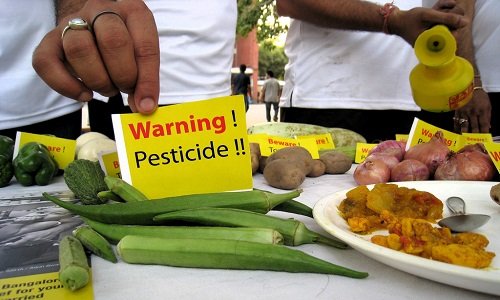Pesticide residue in foods : Green pesticides to the rescue
Few months ago, I noticed that my family always experienced boots of abdominal cramps and diarrhea sometimes when we eat some beans, rice and leafy vegetables.
Other times when I buy from another source we don’t have the abdominal pains and diarrhea. I then decided to plant vegetables in my garden to establish whether we were reacting to vegetables generally or the source. I didn’t use any pesticide during this period even though I noticed the actions of insects on some of the vegetable leaves.
Throughout the period when we consumed only the homegrown vegetables, we didn’t experience any crisis as in prior cases when we ate the ones purchased from the market. I then did the same with beans though I could only harvest a bowl full, but the result was the same; there were no complaints of cramps or boots of diarrhea.
I decided to read more and also consulted medical professionals and agriculturalist about it, the most reoccurring plausible cause given is the residue from pesticides used on the farms where the vegetables and beans were grown. I then recollected the cases of killer beans in South western Nigeria in 1996 and Northern Nigeria in 2011 which researchers attributed to effect of excessive use of some harmful pesticides which were residual in the grains.
Moreover, In China, about 300 cases of poisoning were reported rising from the consumption of sweet potatoes and vegetables. The poison was attributed to the high load of pesticide residue from uncontrolled application of pesticides used by local farmers see here. These farmers were not enlightened about the type of pesticide which are harmful to mammals and their maximum limit for safety of human consumption of the food crops. Pesticide residue has also been reportedly found in some green and black tea bags see here. The Canadian Food Inspection Agency reported that one out of four teas contain pesticide residue far above the safety limit set by the agency.
These are just few of reported cases of effect of pesticide residue in different parts of the world
Use of Pesticides
Pesticides are chemical compounds or mixture of chemical compounds used for annihilating pests. Pests in this case could be insects, rodents, birds, fungi or weeds. Pesticides re originally used to protect crops from being ravaged by these pests.
The use of pesticides is essential in reducing crop losses incurred by farmers. The common types of synthetic organic pesticides are organochlorine and organophosphates. These pesticides though extremely effective in eradicating pests could be very toxic to humans. They accumulate in the environment after use and could spread to non-target organisms through the consumption of the affected food crops.
Pesticides include:
- Herbicides- used against weeds and other harmful plants
- Rodenticides-against rats, mice
- Fungicides –against fungi like mushrooms
- Avicides- against birds
- Insecticides – against insects
Pesticide residue in foods
Pesticide residue is the remains of pesticides in food after they are applied to plants and food crops. The maximum permissible levels of these residues in foods are often set by regulatory bodies in most of the developed countries. When humans are exposed to these residues whether through inhalation of persistent pesticide residue in the atmosphere or through consumption of treated food crops, they could be adversely affected.
Many of these pesticide residues, especially organochlorine pesticides bio accumulate and build up in the body to harmful levels. pesticide residues persist in the environment and accumulate in food products ranging from fish, meat, poultry, vegetable oils, nuts, various fruits and vegetables. However, with the growing world population, pesticides are necessary evils to cut down food crop losses caused by pests.
Effects of pesticide residue on human health
Pesticides and their residue are potentially toxic to humans. They result in both acute and chronic health issues, depending on the quantity and ways in which a person is exposed. When we ingest food containing high level of pesticide residue above the safety limit, or we have direct contact with pesticides over time, we run the risk of adverse effect on liver, kidney or testis including brain damage in children. Early symptoms include; headaches, nausea, abdominal cramps, diarrhea dizziness, muscle twitching and seizures in children. The residues could be transferred from a pregnant woman to the unborn child thereby wreaking havoc on the fetus or from nursing mother to the breastfeeding infant. This is because most of these synthetic organic pesticides accumulate in fat tissues of mammals when directly or indirectly exposed to them. How then do we get rid of or minimize these side effects?
Green pesticides to the rescue
Green pesticides are natural less harmful, low-toxic chemical substances from plants or, mineral sources which are effective in killing pests (insects, nematodes, birds, fungi, weeds harmful to plants or crops). Not all natural pesticides have low-toxicity to humans, but those which re relatively of low-toxicity re referred to as green pesticides. They could be obtained from broad range of sources which include:
- Botanical extracts (plants)
- Essential oils
- Minerals
Botanical insecticides
These are plants with toxins effective in killing insects. They are rapid in action, degrade fast and are mostly of low toxicity towards humans. Examples of such are:
Pyrethrum (Chrysanthemum cinerariaefolum): a daisy plant flower mostly grown in Kenya.
It contains a chemical substance pyrethrin which is toxic to insect but of low-toxicity to humans. It is a contact poison and could be broken down on exposure to ultraviolet radiation.
Sabadilla derived from the ripe seeds of Schoenocaulon officinale grown in Central and South America. It has the least toxicity towards human of all the botanical pesticides.
Essential oils derived pesticides
Some volatile plant oils are effective in eradicating pests and yet are relatively non-toxic to humans. Read more on essential oils in my previous post here
Hence, they are viable alternatives which could be used to reduce the risk posed by the application of synthetic organic pesticides. Examples are;
Citrus peel oils: Citrus fruits peels contain essential oils made up of limonene and linalool.
Most citrus fruit peels contain about 90% limonene, while linalool is highly concentrated in herbs and flowers. These peel oils possess low-toxicity towards human, but t very high concentration could be irritating to skin and eyes.
Neem oil : This is essential oil derived from the leaves of Neem tree. It is especially good because insect pests cannot develop resistant to it, and it has low-toxicity towards humans. Other examples are cedar oil, lavender oil, eucalyptus and citronella oil.
Mineral sources :
some minerals have been discovered to be effective against pests and relatively harmless to man. They include kaolin, limestone, Boric acid and so on.
In the light of these points, one could safely conclude that green pesticides could be the panacea to the challenges posed by pesticide residues in food.
Thanks for stopping by to read my post.
References
https://thesensiblegardener.com/green_pesticides/
http://pestweb.com/assets/files/pestweb/businesstools/NaturalPesticides.pdf
https://dailyhealthpost.com/pesticides-tea/
https://www.epa.gov/sites/production/files/documents/rmpp_6thed_ch5_organophosphates.pdf
http://article.sciencepublishinggroup.com/html/10.11648.j.ajbio.s.2016040301.13.html
https://www.epa.gov/safepestcontrol/food-and-pesticides









This post has been voted on by the steemstem curation team and voting trail.
There is more to SteemSTEM than just writing posts, check here for some more tips on being a community member. You can also join our discord here to get to know the rest of the community!
My final year project was on the effects of chemical fertilizers and pesticides on water quality in a farm settlement, the results of the effects of these pesticides were astounding
Chemical pesticides really are a menace and a risk to human health....Thanks for thus write up
Yes, syntethic chemicals could be detrimental to human health and the environment in general. However, we also have some natural chemicals that are equally hazardous. They are necessary evils. Thanks for stopping by.
wow. This is a really good post thanks for share this information!
Thanks.
Congratulations @conas! You have completed the following achievement on Steemit and have been rewarded with new badge(s) :
Click on the badge to view your Board of Honor.
If you no longer want to receive notifications, reply to this comment with the word
STOP